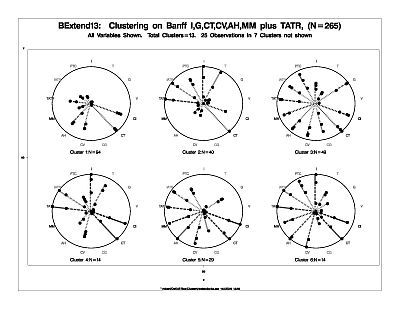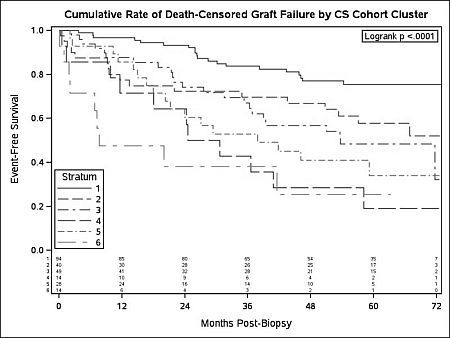DeKAF Pathology Clusters: Follow Up at 5 Years
Department of Medicine, University of Manitoba, Winnipeg, MB, Canada
Meeting: 2013 American Transplant Congress
Abstract number: C1308
The goal of DeKAF was to determine whether clinicopathological and laboratory criteria identify, at the onset of graft dysfunction, patient (pt) subgroups with differing prognoses. Computer-generated clusters (n=6) using Banff histological features were obtained from late (mean time 6+/-1 years post-tx), centrally read, biopsies (bx) from 240 pts from 7 centers (US and Canada). These clusters had differing graft survival (GS) after 18 months. DeKAF also reported a negative effect of donor-specific antibody (DSA) and peritubular capillary c4d deposition (C4d) on death-censored GS. We now report 5 year follow-up of the pt clusters. As shown in figure 1, all clusters show interstitial fibrosis, tubular atrophy and arteriolar hyalinosis.

Cluster 1 differs from the others by having less inflammation in all kidney compartments: normal and atrophic tubulointerstitium, glomeruli and peritubular capillaries. DSA was present in 28% of Cluster 1 pts and in 37%-58% in the others; C4d was similarly distributed across clusters, and both exerted independent effects on GS [DSA (p=0.001); C4d (p=0.038)].The 5-year death-censored GS for the clusters is shown in figure 2.

Kaplan-Meier estimates of death-censored GS differed between clusters (p<0.0001). In proportional hazards regression, all clusters had worse survival than Cluster 1 (p=0.001), after adjusting for the negative effects of DSA and C4d. GS was unchanged after adjustment for time from tx to bx. In conclusion, we confirm that renal tx pts with new-onset late dysfunction can be grouped into histopathological clusters with differing 5-year GS that is independent of DSA and C4d. Incorporation of clinical factors (e.g. rejection history) and additional laboratory features (e.g. complement fixing DSA) may improve cluster prognostic performance.
To cite this abstract in AMA style:
Rush D, Leduc R, Connett J, Cosio F, Gaston R, Mannon R, Hunsicker L, Gourishankar S, Halloran P, Cecka M, Grande J, Kasiske B, Matas A. DeKAF Pathology Clusters: Follow Up at 5 Years [abstract]. Am J Transplant. 2013; 13 (suppl 5). https://atcmeetingabstracts.com/abstract/dekaf-pathology-clusters-follow-up-at-5-years/. Accessed December 20, 2025.« Back to 2013 American Transplant Congress
